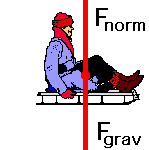In a previous unit, it was stated that all objects (regardless of their mass) free fall with the same acceleration – 9.8 m/s/s. This particular acceleration value is so important in physics that it has its own peculiar name – the acceleration of gravity – and its own peculiar symbol – g. But why do all objects free fall at the same rate of acceleration regardless of their mass? Is it because they all weigh the same? … because they all have the same gravity? … because the air resistance is the same for each? Why? These questions will be explored in this section of Lesson 3.
In addition to an exploration of free fall, the motion of objects that encounter air resistance will also be analyzed. In particular, two questions will be explored:
· Why do objects that encounter air resistance ultimately reach a terminal velocity?
· In situations in which there is air resistance, why do more massive objects fall faster than less massive objects?
To answer the above questions, Newton’s second law of motion (Fnet = m•a) will be applied to analyze the motion of objects that are falling under the sole influence of gravity (free fall) and under the dual influence of gravity and air resistance.


